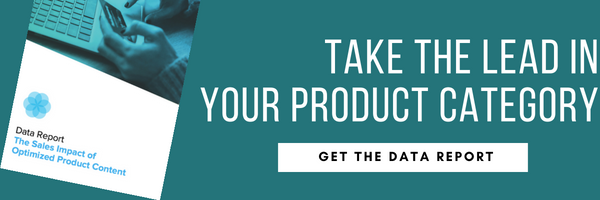How to Calculate the ROI of Product Content | Salsify

It’s the time of year when the final ink on your budget for next year is not yet dry. You may find yourself in many conversations looking back at how the year has gone and making estimates on what it will take for you to achieve your goals for the next year. It’s critical for you to get an honest look at how the product content machine at your brand is serving the rest of your business.
Investing in product experience management (PXM) can improve content accuracy and brand consistency. PXM can also have a big impact on productivity because it’s way easier for internal teams to collaborate cross-functionally and ultimately allow internal consumers of content to find what they need to be successful. However, it can be difficult to attach an exact dollar amount to these productivity improvements.
We recommend looking at the sales impact of product content. Aggregated studies of leading brands found that more content = higher search ranking and more conversions. We see our customers tie the investment in PXM directly back to four key drivers of the ROI:
- Decrease Time to Market. How long does it take to launch a new product on a sales channel? Increasingly retailers are asking for more and more product content directly from the brands before they can begin selling merchandise online. To get new products to market faster - and to update or refresh existing product promotions quickly - brands and retailers need a product content management process and technology in place. For example, Salsify customer Globe Electric went from spending weeks to get a product up and live, to minutes.
- Increase Product Page Conversion. How many people that visit a product page on a given site are adding the product to their cart and hitting the buy button? Research shows that pages with great product content perform better. Rawlings Sporting Goods used Salsify to launch its ecommerce direct-to-customer channel and improve the product experience shoppers had online in order to increase sales.
- Expand SKU Count. How many SKUs are launched and sold on key retailers? Pulling from a trusted source of content for every SKU makes it easier to share a wider assortment with all your sales channels, be they retailers, distributors, or internal sales force. Salsify customer and sleep products maker Soft-Tex® grew active ecommerce SKU count by 117% in just 7 months.
- Grow Market Share. How do your product perform against others in the same category? One key way to measure if by looking at your sales rank on specific retailers relative to the rest of your category. Salsify customer and adhesive maker ShurTech improved its sales rank by 15% on Amazon in 4 months.

How to Calculate Product Content ROI
Increased Traffic x Higher Conversion Rate = More Revenue
The first framework for measuring the impact of product experience management is through the lens of a traditional marketing funnel - from page views to sales. In the example below, an air conditioner manufacturer sells an in-home unit for $584. They have invested in product experience management to improve findability and conversion and seen for this product alone a 10% increase in revenue based on getting improved content into market. Multiply that across a product line and/or multiple brands and revenue grows. Use this calculation to show your team and your supervisor the direct correlation between investing in product content leading to more product sales.
Days to Market Improvement x SKUs Launched x Price = Incremental Revenue
If your business can improve the speed of new product launches across new sales channels, the number of selling days for a given set of products grows and with it your potential sales. For example, if you are launching 50 new premium headphones which sell for $103.99, and you can get 22.5 additional selling days per product, there is a significant increase in revenue simply by getting to market faster. In this scenario, a faster time to market resulted in more 3 more weeks of sales time and more than $300K in additional revenue. In some cases a faster time to market could allow a brand to release products to more retailers or launch more products in key marketplaces. For retailers that rely heavily on search or recommendation engines, a faster time to market can also mean the difference between ranking higher in your product category.
Ultimately, investing in product experience management makes it possible to thrive in ecommerce. It’s critical to demonstrate that value in real terms to others in your organization. Effective product experience management requires a change in people, processes, and technology. By connecting your investments in process and technology to incremental revenue, you’ll be able to get everyone in your organization on board and show how important product content can be.
Earlier this year Salsify commissioned Forrester Consulting to conduct a Total Economic Impact (TEI) study and examine the potential return on investment companies may realize by deploying Salsify’s Product Experience Management (PXM) platform. The study provides a much-needed framework you can use to evaluate the potential financial impact a technology investment could have on your organization. The study shows a return on investment of over 300% and a payback period of 7 months.
Tag(s):
Omnichannel Commerce Strategy
Written by: Cara Wood
Cara Wood (she/her) is a writer and former director of brand journalism at Salsify, where she specialized in creating content to help brands excel in ecommerce. Her work has helped organizations enhance their digital shelf and product experience management strategies.
Recent Posts
Ecommerce Marketing
|
12 minute read
The Art of the Impulse Buy: 70% of Shoppers Say Discounts Drive Unplanned Purchases — Here’s Why
Read More
Ecommerce Marketing
|
10 minute read
What Does It Take To Have a Good Brand Reputation in 2025?
Read More
Ecommerce Trends
|
11 minute read
What Is Commerce Media — and How Can It Optimize Your Marketing Spend?
Read More
Subscribe to the Below the Fold Newsletter
Standing out on the digital shelf starts with access to the latest industry content. Subscribe to Below the Fold, our monthly content newsletter, and join other commerce leaders.


.svg)